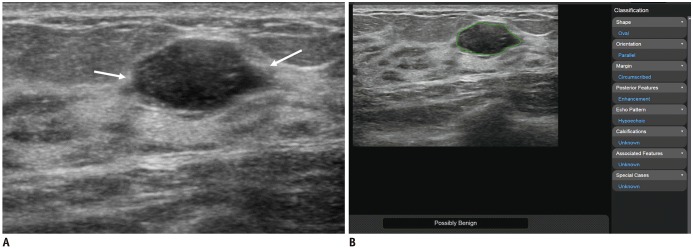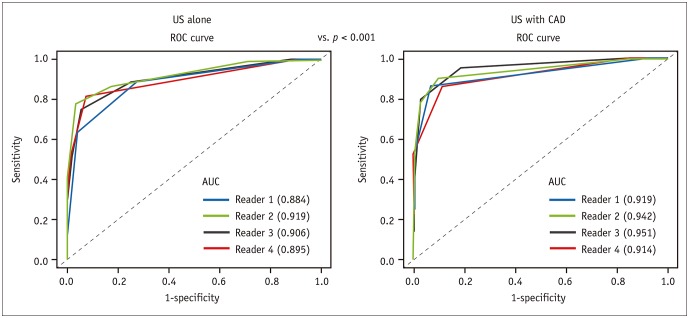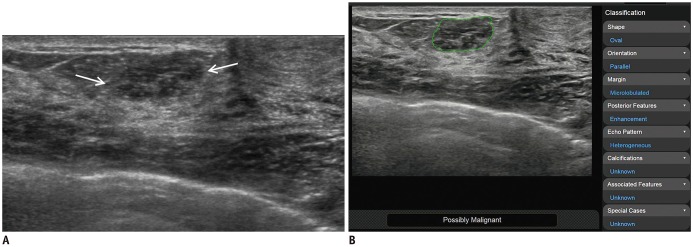Korean J Radiol.
2019 May;20(5):749-758. 10.3348/kjr.2018.0530.
Effect of a Deep Learning Framework-Based Computer-Aided Diagnosis System on the Diagnostic Performance of Radiologists in Differentiating between Malignant and Benign Masses on Breast Ultrasonography
- Affiliations
-
- 1Department of Radiology, Samsung Medical Center, Sungkyunkwan University School of Medicine, Seoul, Korea. bkhan@skku.edu
- KMID: 2442709
- DOI: http://doi.org/10.3348/kjr.2018.0530
Abstract
OBJECTIVE
To investigate whether a computer-aided diagnosis (CAD) system based on a deep learning framework (deep learning-based CAD) improves the diagnostic performance of radiologists in differentiating between malignant and benign masses on breast ultrasound (US).
MATERIALS AND METHODS
B-mode US images were prospectively obtained for 253 breast masses (173 benign, 80 malignant) in 226 consecutive patients. Breast mass US findings were retrospectively analyzed by deep learning-based CAD and four radiologists. In predicting malignancy, the CAD results were dichotomized (possibly benign vs. possibly malignant). The radiologists independently assessed Breast Imaging Reporting and Data System final assessments for two datasets (US images alone or with CAD). For each dataset, the radiologists' final assessments were classified as positive (category 4a or higher) and negative (category 3 or lower). The diagnostic performances of the radiologists for the two datasets (US alone vs. US with CAD) were compared.
RESULTS
When the CAD results were added to the US images, the radiologists showed significant improvement in specificity (range of all radiologists for US alone vs. US with CAD: 72.8-92.5% vs. 82.1-93.1%; p < 0.001), accuracy (77.9-88.9% vs. 86.2-90.9%; p = 0.038), and positive predictive value (PPV) (60.2-83.3% vs. 70.4-85.2%; p = 0.001). However, there were no significant changes in sensitivity (81.3-88.8% vs. 86.3-95.0%; p = 0.120) and negative predictive value (91.4-93.5% vs. 92.9-97.3%; p = 0.259).
CONCLUSION
Deep learning-based CAD could improve radiologists' diagnostic performance by increasing their specificity, accuracy, and PPV in differentiating between malignant and benign masses on breast US.
Keyword
MeSH Terms
Figure
Reference
-
1. Berg WA, Blume JD, Cormack JB, Mendelson EB, Lehrer D, Böhm-Vélez M, et al. Combined screening with ultrasound and mammography vs mammography alone in women at elevated risk of breast cancer. JAMA. 2008; 299:2151–2163. PMID: 18477782.
Article2. Kelly KM, Dean J, Comulada WS, Lee SJ. Breast cancer detection using automated whole breast ultrasound and mammography in radiographically dense breasts. Eur Radiol. 2010; 20:734–742. PMID: 19727744.
Article3. Hooley RJ, Scoutt LM, Philpotts LE. Breast ultrasonography: state of the art. Radiology. 2013; 268:642–659. PMID: 23970509.
Article4. Ohuchi N, Suzuki A, Sobue T, Kawai M, Yamamoto S, Zheng YF, et al. Sensitivity and specificity of mammography and adjunctive ultrasonography to screen for breast cancer in the Japan Strategic Anti-cancer Randomized Trial (J-START): a randomised controlled trial. Lancet. 2016; 387:341–348. PMID: 26547101.
Article5. Berg WA, Blume JD, Cormack JB, Mendelson EB. Training the ACRIN 6666 Investigators and effects of feedback on breast ultrasound interpretive performance and agreement in BI-RADS ultrasound feature analysis. AJR Am J Roentgenol. 2012; 199:224–235. PMID: 22733916.
Article6. D'Orsi C, Sickles E, Mendelson E, Morris E. ACR BI-RADS® Atlas, breast imaging reporting and data system. 5th ed. Reston, VA: American College of Radiology;2013. p. 1–153.7. Lazarus E, Mainiero MB, Schepps B, Koelliker SL, Livingston LS. BI-RADS lexicon for US and mammography: interobserver variability and positive predictive value. Radiology. 2006; 239:385–391. PMID: 16569780.
Article8. Kim EK, Ko KH, Oh KK, Kwak JY, You JK, Kim MJ, et al. Clinical application of the BI-RADS final assessment to breast sonography in conjunction with mammography. AJR Am J Roentgenol. 2008; 190:1209–1215. PMID: 18430833.
Article9. Stavros AT, Freitas AG, Giselle G, Barke L, McDonald D, Kaske T, et al. Ultrasound positive predictive values by BI-RADS categories 3–5 for solid masses: an independent reader study. Eur Radiol. 2017; 27:4307–4315. PMID: 28396996.
Article10. Abdullah N, Mesurolle B, El-Khoury M, Kao E. Breast imaging reporting and data system lexicon for US: interobserver agreement for assessment of breast masses. Radiology. 2009; 252:665–672. PMID: 19567644.
Article11. Yoon JH, Kim MJ, Moon HJ, Kwak JY, Kim EK. Subcategorization of ultrasonographic BI-RADS category 4: positive predictive value and clinical factors affecting it. Ultrasound Med Biol. 2011; 37:693–699. PMID: 21458145.
Article12. Doi K. Computer-aided diagnosis in medical imaging: historical review, current status and future potential. Comput Med Imaging Graph. 2007; 31:198–211. PMID: 17349778.
Article13. Joo S, Yang YS, Moon WK, Kim HC. Computer-aided diagnosis of solid breast nodules: use of an artificial neural network based on multiple sonographic features. IEEE Trans Med Imaging. 2004; 23:1292–1300. PMID: 15493696.
Article14. Huang YL, Chen DR. Support vector machines in sonography: application to decision making in the diagnosis of breast cancer. Clin Imaging. 2005; 29:179–184. PMID: 15855062.15. Singh S, Maxwell J, Baker JA, Nicholas JL, Lo JY. Computer-aided classification of breast masses: performance and interobserver variability of expert radiologists versus residents. Radiology. 2011; 258:73–80. PMID: 20971779.
Article16. Alam SK, Feleppa EJ, Rondeau M, Kalisz A, Garra BS. Ultrasonic multi-feature analysis procedure for computer-aided diagnosis of solid breast lesions. Ultrason Imaging. 2011; 33:17–38. PMID: 21608446.
Article17. Moon WK, Chen IL, Chang JM, Shin SU, Lo CM, Chang RF. The adaptive computer-aided diagnosis system based on tumor sizes for the classification of breast tumors detected at screening ultrasound. Ultrasonics. 2017; 76:70–77. PMID: 28086107.
Article18. Tourassi GD, Frederick ED, Markey MK, Floyd CE Jr. Application of the mutual information criterion for feature selection in computer-aided diagnosis. Med Phys. 2001; 28:2394–2402. PMID: 11797941.
Article19. Newell D, Nie K, Chen JH, Hsu CC, Yu HJ, Nalcioglu O, et al. Selection of diagnostic features on breast MRI to differentiate between malignant and benign lesions using computer-aided diagnosis: differences in lesions presenting as mass and non-mass-like enhancement. Eur Radiol. 2010; 20:771–781. PMID: 19789878.
Article20. Yang MC, Moon WK, Wang YCF, Bae MS, Huang CS, Chen JH, et al. Robust texture analysis using multi-resolution gray-scale invariant features for breast sonographic tumor diagnosis. IEEE Trans Med Imaging. 2013; 32:2262–2273. PMID: 24001985.
Article21. Han S, Kang HK, Jeong JY, Park MH, Kim W, Bang WC, et al. A deep learning framework for supporting the classification of breast lesions in ultrasound images. Phys Med Biol. 2017; 62:7714–7728. PMID: 28753132.
Article22. Russakovsky O, Deng J, Su H, Krause J, Satheesh S, Ma S, et al. Imagenet large scale visual recognition challenge. Int J Comput Vis. 2015; 115:211–252.
Article23. Lee JG, Jun S, Cho YW, Lee H, Kim GB, Seo JB, et al. Deep learning in medical imaging: general overview. Korean J Radiol. 2017; 18:570–584. PMID: 28670152.
Article24. Suk HI, Lee SW, Shen D. Alzheimer's Disease Neuroimaging Initiative. Hierarchical feature representation and multimodal fusion with deep learning for AD/MCI diagnosis. Neuroimage. 2014; 101:569–582. PMID: 25042445.
Article25. Hua KL, Hsu CH, Hidayati SC, Cheng WH, Chen YJ. Computer-aided classification of lung nodules on computed tomography images via deep learning technique. Onco Targets Ther. 2015; 8:2015–2022. PMID: 26346558.26. Lakhani P, Sundaram B. Deep learning at chest radiography: automated classification of pulmonary tuberculosis by using convolutional neural networks. Radiology. 2017; 284:574–582. PMID: 28436741.
Article27. Cheng JZ, Ni D, Chou YH, Qin J, Tiu CM, Chang YC, et al. Computer-aided diagnosis with deep learning architecture: applications to breast lesions in US images and pulmonary nodules in CT scans. Sci Rep. 2016; 6:24454. PMID: 27079888.
Article28. Bennett B. On comparisons of sensitivity, specificity and predictive value of a number of diagnostic procedures. Biometrics. 1972; 28:793–800. PMID: 5073252.
Article29. Barlow WE, Chi C, Carney PA, Taplin SH, D'Orsi C, Cutter G, et al. Accuracy of screening mammography interpretation by characteristics of radiologists. J Natl Cancer Inst. 2004; 96:1840–1850. PMID: 15601640.
Article30. DeLong ER, DeLong DM, Clarke-Pearson DL. Comparing the areas under two or more correlated receiver operating characteristic curves: a nonparametric approach. Biometrics. 1988; 44:837–845. PMID: 3203132.
Article31. Kim SA, Chang JM, Cho N, Yi A, Moon WK. Characterization of breast lesions: comparison of digital breast tomosynthesis and ultrasonography. Korean J Radiol. 2015; 16:229–238. PMID: 25741187.
Article32. Landis JR, Koch GG. The measurement of observer agreement for categorical data. Biometrics. 1977; 33:159–174. PMID: 843571.
Article33. Berg WA, Cosgrove DO, Doré CJ, Schäfer FK, Svensson WE, Hooley RJ, et al. Shear-wave elastography improves the specificity of breast US: the BE1 multinational study of 939 masses. Radiology. 2012; 262:435–449. PMID: 22282182.
Article34. Lee SH, Cho N, Chang JM, Koo HR, Kim JY, Kim WH, et al. Two-view versus single-view shear-wave elastography: comparison of observer performance in differentiating benign from malignant breast masses. Radiology. 2014; 270:344–353. PMID: 24029644.
Article35. Sultan LR, Bouzghar G, Levenback BJ, Faizi NA, Venkatesh SS, Conant EF, et al. Observer variability in BI-RADS ultrasound features and its influence on computer-aided diagnosis of breast masses. Advances in Breast Cancer Research. 2015; 4:1–8.
- Full Text Links
- Actions
-
Cited
- CITED
-
- Close
- Share
- Similar articles
-
- Which supplementary imaging modality should be used for breast ultrasonography? Comparison of the diagnostic performance of elastography and computer-aided diagnosis
- Reproducibility and diagnostic performance of the vascular index of superb microvascular imaging in real-time breast ultrasonography for evaluating breast masses
- The Value of Ultrasonography Combined with Compression Technique in Differentiation between Benign and Malignant Breast Masses
- A Comparative Study of the Diagnostic Performance of Evaluating Breast Masses for Breast Surgeons versus S-Detectâ„¢ (Samsung Medison Co., Ltd, Seoul, Korea)
- Clinical application of S-Detect to breast masses on ultrasonography: a study evaluating the diagnostic performance and agreement with a dedicated breast radiologist





